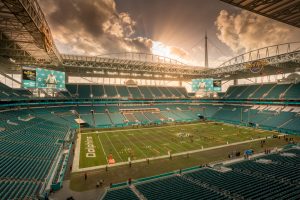Tech Focus: Venue Sound, Part 1 — Audio Integrators Look To Enhance the Fan Experience
Advanced systems enable stadiums, arenas to attract entertainment events
Story Highlights
Over the past two decades, sports broadcasts have been evolving toward cinema, deploying multichannel sound and enhanced effects audio worthy of the Star Wars franchise. Today, the venues have taken note and, like the Empire, are beginning to strike back, offering sound systems give fans in the stands an experience resembling the one they would have at home.
“We’re seeing more concert-level sound systems going into stadiums and arenas now,” says Justo Gutierrez, director of sound and A/V, sports venues, for systems integrator Diversified, whose portfolio includes the Dolphins’ Hard Rock Stadium in Miami.
That’s due in part to the need to make sports venues more accommodating to a wider array of events, from music concerts to touring theatrical shows, such as Disney on Ice. That has become a broader trend in this sector, with venue stakeholders, such as counties and municipalities, demanding improved ROI from stadiums whose price tags have crept past the $1 billion mark, such as the $1.15 billion Cowboys Stadium and $1.6 billion MetLife Stadium. In the process, venue designers are increasingly specifying what’s known as “rider-friendly” sound systems, specifically targeting top-line music shows and other touring productions. The improved sound is also setting the stage for a kind of cinematic sound experience in the venue.
Paul Murdick, GM, technology solutions, at TSI Global, a systems integrator whose sports portfolio includes Busch Stadium, Citi Field, and Edward Jones Dome, says these advanced audio systems are finding their way into venues not necessarily as the main draw for touring shows but as extensions of those shows’ own systems, expanding their reach within the venue. “They’re able to augment the tour requirements, is what I have seen,” he explains. “The end user/owner is driven by customer-satisfaction experience, and that seems to justify the investment being made for music-concert–quality systems.”
More-Creative Sound
“It’s not just sports anymore, it’s entertainment,” notes Vance Breshears, director at consultancy Idibri, whose portfolio includes AT&T Park in San Francisco and Chase Field in Phoenix. “Venues today, from their architecture to their technology systems, are being designed for one thing: the fan experience, the impact on people. In many ways, they’re no different from performing-arts center, only more demanding.”
That enables sound to be more creatively used in venues, according to Pete O’Neil, director, engineering, Diversified. “We’re going to see sound used in more ways than it has been used before in stadiums and arenas, including sound as an effect, not just for announcements,” he says. “The sound in stadiums is evolving, and sound systems are going to be used to literally alter the environment there. We’ll be able to bring the ice sounds up to the top rows” for ice shows and hockey, something he says only television viewers might have enjoyed before.
That is readily accomplished, he points out, thanks to greater use of networked audio, which lets different elements and zones of a large system be individually controlled. “You used to be able only to send the same signal everywhere. Now we can [zone] the system and mix the entire venue like it was a stage.”
Adds Gutierrez, “We can bring the sound of the skate blades or the squeaks of the sneakers to the stands, no matter where the seat is. [Fans] in the venue can have some of the same experience [viewers] get at home on television.”
As important, notes O’Neil, venue owners and managers are now aware of what the possibilities are with this generation of live-sound technology and are specifically asking for such capabilities. “The buildings are becoming less about just sports and more about entertainment. It’s opening up new possibilities. They see that.”
Click here for Tech Focus: Venue Sound, Part 2 — A Thriving Market Poses Challenges for System Suppliers

